#bb meta
Text

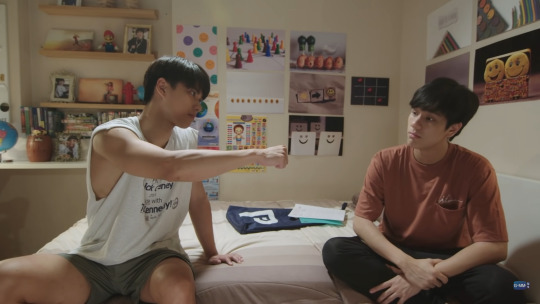

The first fist bump we see in Bad Buddy is between Pat and his dad. Pat's dad has just said he used to protect the girls in his faculty from the nefarious Architecture boys and the two are celebrating his coolness.
Later that episode, Pat comes to Pran to propose a truce in the Engineering and Architecture fight. Pran suggests a plan, Pat agrees, and he holds a fist out to seal the deal. Pran seems surprised at first, but then reaches out and fist bumps Pat. A iconic gesture is born.
I don't have the words or time to get into this right now so you'll just get some ramblings:
the fist bump being a gesture Pat learned from his dad (his macho, "did you win the fight son?" dad)
Pats instinct to seal the deal, a deal that will end the fighting with compromise, is with a gesture learned from his father
Pat taking the tools he learned from his dad (posturing, fighting, being the best, etc.) and using them in a way that better suits who he really is, under everything his dad wanted him to be (compromise, cooperation, connection to Pran)
the way this gesture, the fist bump, becomes THE symbol of Pat and Pran's love, a love that Pat's father cannot tolerate and tries to forbid, and is present at all the important moments in their relationship (the beginning of the bet, the public confession on the stairs, etc.)
the way the first bump becomes not a gesture for brash male posturing, competition, and bonding in the most heteronormative sense (protecting women from other men) but instead a gesture for peace, cooperation, and love, a symbol of a gay relationship that endures despite societal and familiar pressures
144 notes
·
View notes
Text







Like a lot of longtime characters, Kazuma was first made playable as a 3⭐ in BBDW- though rumors and datamines suggest there were plans for him to appear in Chronophantasma at some point, as Terumi has an unused line addressing him in that game.
See also;
[Gameplay]
From the start, Kazuma was a very interesting character to me. At the start, I assumed the Kazuma in BBDW had never made contact with Terumi- and as the story went on, dropping hints of a Terumi-possessed Trinity, I started to think BBDW Kazuma would never become a host.
But the mechanics of the game would suggest otherwise. At the start of BBDW's run, there was this really interesting mechanic where character's special attacks, such as their Astral Heats, were locked a sort of leveling system. (I thought this was a fun touch, though they removed it later into the game's lifespan.) This meant that you wouldn't be able to see a character's Astral until you'd raised them for a while.
Well, unless you watched their character trailers, which always showcased the Astral Heat at the end!
With the sole exception of Kazuma's. We never got to see Kazuma's Astral in promotional materials, while other starting characters like Trinity and Ciel had theirs shown off during early streams.
Which was incredibly suspicious.
Once you did finally unlock Kazuma's Astral Heat ingame, you'd find it very similar to Hazama's traditional Astrals- he's possessed by Terumi, and begins using his powers. Outside of that Astral, Kazuma was never shown using Ouroboros or any of Terumi's snakey magic.
We also see that familiar green haze in Kazuma's third card art- I wonder if that was also a hint. Speaking of Kazuma's character art!
Kazuma is shown in Ishana- in his final art he's in the library he loved so much. I'm not sure what the building in his initial art is. Could it be the cathedral? A normal school building? The library again? Maybe I need to read Phase Shift again and refresh my memory.
His first outfit is the same outfit he debuted in in Phase Shift 1. It's also the same outfit Rei, the player character, wears- minus the tie, which is different between the two. This may suggest the two are in different grades, but I can theorize about that another time.
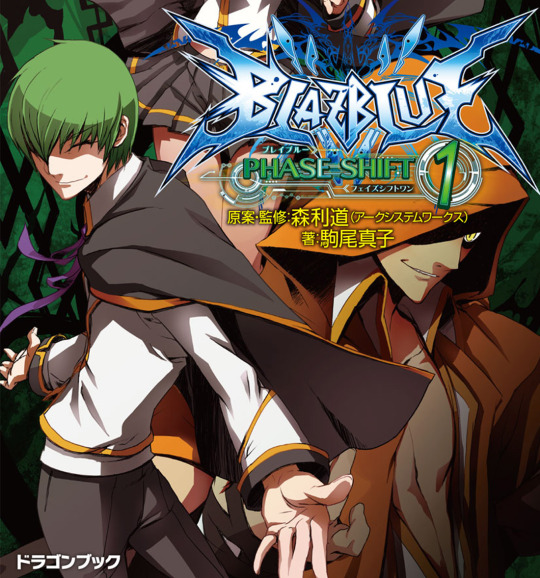
Kazuma is famous for another outfit- the hooded version worn by him and Terumi during the Dark War, which you can see Terumi wearing in the background of this image. However, Kazuma never had this costume in BBDW. I wonder if it would have appeared as one of Terumi's three outfits when his Chronophantasma version was added to the game.
Kazuma's later two outfits are very similar to his Ishanan school uniform, though they become more elaborate and fancy. The outfits are completely original to BBDW. They could be reflective of Kazuma's personal taste- he's only familiar with the uniform, it's the only clothing he's ever had, and he's a pretty complacent guy, so he'd likely be drawn to clothing he's already familiar with if he had to shop.
Or, could these outfits be reflective of more Ishanan formal wear? Could they also have a role in Mage Guild culture?
I guess we'll never know!
#kazuma kval#blazblue#blazblue alternative dark war#blazblue phase shift#phase shift#bbdw#by rokushirokoushi#ao no imakagami#yuuki terumi#takehaya susanoo#bb meta
39 notes
·
View notes
Note
Healing Church's attitude:
"Why isn't he dead? Are you talking? Who told you to do that? You don't talk. You don't think. I think, you kill. It's a simple fucking concept!"-Odin, God of War.
Thx for the ask! For reference, I start with a short summary of the Healing Church’s history.
The origin of the Healing Church can be traced back to Byrgenwerth and the Tomb of the Gods, also known as Chalice Dungeons, where Master Willem and Laurence discovered the power of the Great Ones and the Old Blood. They thought they could use this knowledge to find a way that would allow humans to evolve to a higher plane of existence. Laurence was convinced that blood was the key to achieving their goal, while Master Willem wanted to find an alternate way to connect with the Great Ones and refused to use the blood. This led to Laurence’s departure from Master Willem and the foundation of the Healing Church. Laurence was convinced that blood is beneficial and wanted to use it to cure illnesses. He founded the Cathedral of Oedon. The Formless Oedon is a Great One associated with blood (Human or no, the oozing blood is a medium of the highest grade, and the essence of the formless Great One). The Healing Church used nuns as vessels to provide good blood to citizens of Yharnam and cured their diseases. The consumption of blood outside of the Church was strictly forbidden. While the blood healed many, it came with a prize when people started to turn into beasts driven by base desires, particularly when the red moon hung low and the line between men and beasts was blurred. To prevent the scourge of beasts, the Healing Church founded the hunters. Gehrman, the First Hunter, received a workshop hidden in the Healing Church and trained future hunters. The Healing Church also experimented with different types of blood, which likely should bring them closer to their goal and cure/prevent the beastly scourge. At one point, Laurence himself succumbed to beasthood and turned into a cleric beast. Under him, the Church still had good intentions and tried to help people, even if it was somewhat of a side effect in his search for human evolution.
With Laurence gone, the Healing Church changed, and his vision became distorted. The Church split into different subgroups, but I won’t discuss them here since it’s irrelevant now. The Healing Church’s clerics continued to use blood. However, helping people has become less relevant than expanding their power, which led to the catastrophe of Old Yharnam. They likely poisoned the water supply of Old Yharnam, causing an outbreak of Ashen Blood, a contagious and deadly disease. Ashen Blood was treated with an antidote, which only brought temporary relief. Conveniently, the Healing Church provided help through blood healing. What should have been a blessing turned into a curse since Ashen Blood triggered the beastly scourge. Facing a mass transformation of Old Yharnam’s citizens catalyzed by the red moon, the Church blocked the bridge to the Cathedral Ward and Central Yharnam during a hunt. The entire district and its people were burned to prevent the Ashen Blood and the scourge from spreading further. Despite the disastrous consequences, they didn’t learn from their mistakes, and the downward spiral continued.
New types of beasts emerged, bigger and stronger ones, and hunts became regular occurrences. The Healing Church established official church hunters, many of them were clerics, under Ludwig, the Holy Blade. The black church hunters were doctors that should prevent the beastly scourge. They mercilessly disposed of victims of the scourge of beasts and even potential victims before signs of sickness became visible. This also opened ways to silence effectively those who speak against the Church. The white church hunters were superiors to black hunters. They were doctors that thought medicine was not a treatment but a method for research and that some knowledge was only obtained by exposing oneself to sickness. This mentality and the direct connection to the blood ministration may also explain why members of the Healing Church turn into much more vicious beasts.
At one point, Ludwig started to recruit ordinary people for the hunt, which further aggravated the situation. Now those who gave in to their bloodlust turned even faster into beasts. Yharnam was lost. It ended in a nightmare with most of its people, including the Healing Church members, either transformed or dead. The ritual performed by the School of Mensis that summoned the red moon, which again caused a mass transformation of the Yhanamites, sealed the deal for the city. But even before that, the situation was likely already (almost) out of control. Coffins can be seen everywhere on the streets. I think there were already so many people dying that they couldn’t keep up with the funerals, and later, with the start of the ritual, they didn’t care anymore.
Discussion
When it comes to the morality and attitude of the Healing Church, it is essential to differentiate between the Church under Laurence and after Laurence. The original Church was less shady and still followed the credo: “Fear the Old Blood” instead of the later “Seek the Old Blood”. I assume only people with otherwise incurable diseases and severe cases received blood healing in the beginning. Also, the hunters were not immediately founded along with the Church, but when the first people transformed into beasts. This suggests that Laurence was initially either unaware of the side effects or overly confident regarding his approach.
Ludwig is known as the first hunter of the Church, but it was, in fact, Gehrman who came first. Ludwig was likely the first hunter officially recognized by the Healing Church. The original workshop is also hidden. Therefore, the first hunts were likely carried out in secrecy. During the early days of the Healing Church, people turning into beasts were probably only isolated cases. Taking care of the problem without attracting too much public attention should have been possible. I think we can assume that the first hunters under Gehrman were well-selected. They must have been loyal to the Church, like Clerics, or at least supported its action, which means they participated voluntarily in the hunts. This can be supported by the fact that the weapons of the first hunters weren’t as effective as the later equipment. The hunts were risky for the hunters. If they didn’t believe in what they were doing, why would they risk their lives?
You can call Laurence’s actions questionable, but overall I think that during this early stage of the Healing Church, they are still justifiable. The Healing Church brought prosperity to Yharnam and its citizens. And as long as only severely ill people received blood healing, the procedure helped more than it harmed, provided that these people didn’t hurt or kill anyone else during or after the transformation. They were doomed to an early death anyway or elongated suffering. Even if they turned into beasts and had to be killed, they still got more time to live or at least a better living quality before their demise.
So, I think the quote does not directly fit this era. While the Healing Church was the initiative power behind the hunts and likely recruited suitable hunter candidates, I think they didn’t have to enforce anything. The hunters were probably convinced that their deeds served a noble goal. Here’s an in-game quote I find more suitable for this era: “Acts of goodness are not always wise, and acts of evil are not always foolish, but regardless, we shall always strive to be good.” Logarius.
We should also consider what the hunters did or didn’t know about the origin of the beastly scourge. It was presented as a communicable disease, so maybe many of them weren’t aware of the connection to the blood.
A turning point was the foundation of the church hunters, which made the beastly scourge and the hunts public, and the catastrophe of Old Yharnam. This is just speculation, but I think both events happened in close temporal proximity. The church hunters were founded because the Church wanted more effective weapons to fight larger and stronger beasts. With more people receiving blood healing in Old Yharnam, more people turned into beasts. With more people turning into beasts, the possibility of some of them evolving into stronger beasts was higher. So, I think the church hunters were founded after the events of Old Yharnam already started, but still, a while before the situation escalated.
In my opinion, the quote fits the events of Old Yharnam well. Here the Church did not only initiate the events but also dictated how the hunters should deal with the situation. Other solutions were apparently not considered or not welcomed. In Old Yharnam, you can find the message: “The red moon hangs low, and beasts rule the streets. Are we left no other choice, than burn it all to cinders?” It seems like the hunters only reluctantly fulfilled their duties and began to question the practices of the Healing Church. Killing individual people who succumbed to the scourge of beasts is one thing, but committing genocide on an entire city district is a completely different level. These actions could not be justified anymore, but it was already too late. They can either sacrifice Old Yharnam or face a much worse situation when the now-transformed people reach Central Yharnam. At least Djura changed sides in response to the events and swore to protect the remaining beasts. (“I no longer dream, but I was once a hunter too. There’s nothing more horrific than a hunt. In case you fail to realise, the things you hunt - they’re not beasts, they’re people. One day you will see.”) Along with him, I think it was a waking call for other hunters too, especially those who weren’t clerics.
Afterward, the situation changed again. I already mentioned the church hunters, many of them were clerics. That’s convenient since their goals and morality align much better with those of the Healing Church than it would be the case for other hunters. The ultimate goal of the Healing Church is, after all, reaching the next step of human evolution and connecting with the Great Ones. Morality is subjective. What is acceptable for one person goes too far for another one. The questions here are, “Is it acceptable to sacrifice some lives for a greater good?” and “How many sacrifices are justifiable?” Healing Church members would have a different perspective on the topic than most non-Healing Church members. Another point is that the position of the church hunters offered new possibilities to pursue their own interests. The black church hunters killed people even before the first symptoms became visible. This enabled them to kill anyone for any reason. Who would check if the victim was legit sick or not? Even if the hunter in question had been convicted of being a murderer, the Church could still use the beastly scourge as an excuse for this behavior. The white church hunters weren’t any better. They were likely involved in human experiments. Again, I think the quote only fits here partially. The line between hunters and the Healing Church becomes increasingly blurred, and their interests often correlate. Plus, hunters can now profit from the hunts for personal gains or simply give in to their bloodlust. The Healing Church likely silenced those you openly turned against it, but on a larger scale, there doesn’t seem to be much resistance. It is a self-retaining system that works without much external pressure.
The last point I want to talk about is the civilian recruits. Beasts were presented to them as enemies who harm and kill (which isn't a lie, though). On the other hand, the Church provided help to Yharnam’s citizens. It healed people and now offered a way to protect friends and family directly. That is also a great way to distract from the real problem. Every civilian, who died while participating in the hunt, just increased the hatred for beasts. As long as people concentrated on beast hunts, they were too busy asking questions and connecting the dots between blood healing and the beastly scourge. At the beginning of the game, you see half-transformed people burning a crucified beast. Their hatred burned so deep that they did not even realize that they had become what they hated the most. Again, the Church didn’t have to apply any external pressure. Giving the people an enemy and fueling their hatred was enough. The addictive nature of blood must have been a big help too.
I think how well the quote fits heavily depends on the period you are referring to. But overall, I haven’t found anything about the Healing Church facing a severe backlash outside of the events of Old Yharnam. It also appears that coercion was not needed for the most part. The lack of information regarding the beastly scourge helped them. Spreading misinformation, creating an enemy, and filling up the executive ranks with their own members seemed to be enough to stay in power. Of course, everything here only applies on a larger scale. On an individual level, you will always have people who question the Church or turn against it. Some parted ways; some may have been brought back with pressure and fear.
#bloodborne#laurence the first vicar#ludwig the holy blade#gehrman the first hunter#ask#🩸🌙#meta#bb meta
3 notes
·
View notes
Text
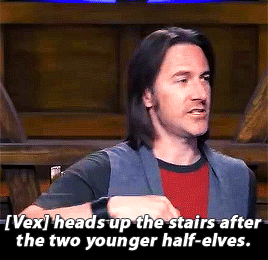

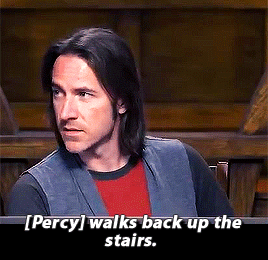
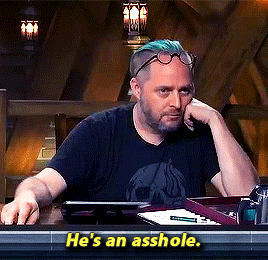
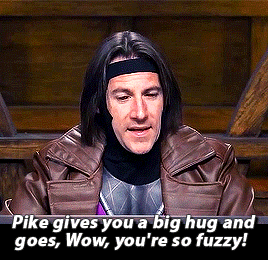
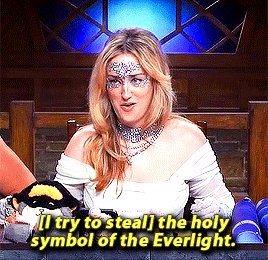
there are three kinds of players
#critical role#criticalroleedit#crc3#crc3edit#crc1#crc1edit#mine#edit#*#category*#precious bb#1k#2k#3k#4k#5k#ashley johnson#laura bailey#taliesin jaffe#idk what brand of narcissistic/meta this whole vm/bh mini arc is but it is my new favorite thing on earth
7K notes
·
View notes
Text

Probably the most powerful expression Oda drew on Law because how many times have we seen him so broken and desperate. That's a boy who lost everyone within a single night along with his faith in humanity - spilling out his heart in front of a total stranger just so he can somehow evade re-experiencing this pain:

And this time it struck him worse . Now there's guilt along with grief because he brought the grim reaper to Cora himself.
Vergo is now dead and Doflamingo in Impel Down - but this isn't something you heal from in lifetime.

Years after, same story. Oda struck the same wound again, took away his sword and hat while at it, then left him in salt water.
#so. today marks a year since law was last seen in the manga#I saw the law crying panel on twitter and teared up because theres no way he isn't going through that exact feeling deep inside rn#a devil fruit user. suffocating under water. wounds exposed to salt. exactly what he's going through inside and out#1 am feels#OK feels aside. for law to 'proceed by himself' he needs some words of assurance that his crews aren't dead or captured by BB#since we saw akainu receiving the news - it's possible that HP are arrested and Law will get their updates from newspaper#one piece meta#mine#trafalgar law#trafalgar d. water law#donquixote rosinante#one piece heart pirates
215 notes
·
View notes
Text
WAIT WAIT WAIT HOLD THE FUCKING PHONE
So normally we only get fullblown, extended and dedicated flashbacks for heroic characters in One Piece, the characters who we're meant to root for. The literal only TRUE exception we've had to this rule was Big Mom's flashback. Even fucking Doflamingo's flashback was tied to Law and Rosinante's
So the fact that we haven't gotten a single fucking GLIMPSE at Crocodile's backstory is?!?

Like sure, we haven't gotten like a Moria flashback, but you know, he literally told us all we needed to know himself, AND we got to see glimpses of him in the Wano flashbacks. Arlong didn't get a flashback of his own, but he did get to cameo in Fisher Tiger's flashback. And Rob Fucking Lucci got a flashback that was 6 whooping panels long
BUT CROCODILE?? Not only do we know almost Fuck All about his story, but also have never gotten as much as a glimpse at it? But his backstory has been HINTED and TEASED at multiple times??
GUYS. FELLAS
Like. I am SURE the "Full Backstories for Heroes Only" rule is going to get broken again, but with Imu and Blackbeard already there just BEGGING to have their beans spilled, can we even be sure Sir Fucking Crocodile is somehow going to become A Villain So Dangerous To The Narrative that he ALSO should also recieve a Full Fucking Backstory?? For his Nefarious Schemes?? AT THIS POINT??
Y'all
I think it's more likely Oda's been saving up Croc's backstory because it might just completely recontextualize his entire character
#CROCODAD REAL?!#UNIRONICALLY#Sir Crocodile#Crocodad#Crocomom#OP Meta#Moon posting#Sleep Deprivation opened my third fucking eye I can see the fucking Matrix#Unironically this is the thing that has pushed me back into actually believing in Crocodad despite the timeline#Because I genuinely can not imagine how else Crocodile could be turned into an (anti) hero if it's not Crocodad#And I can not imagine his villanous schemes needing a backstory to explain them at this point- not over BB and Imu#And I mean sure maybe we could get three whole Extended Villian Backstories for Imu Blackbeard and Croc#But I just feel like it'd be so unnececary#Because there is no fucking way Crocodile is going to become The Ultimate Villian of the Story again#Not without some Darth Vader bullshit happening#But since he's supposed to be based on Wagnas from Romancing SaGa 2 and Wagnas wanted to SAVE the world#Look I have a whole different post about that waiting in my drafts I'll post it later#Point is!! I can't imagine him becoming The Final Villian!! Not at all!!#Also yes there are characters like Mihawk who have like histories etc that I'm sure many people would love to learn about#The only difference is that we've never gotten as much as a hint at what kind of a backstory Mihawk might have#Meanwhile Crocodile Having A History is something that's been hinted at every arc he's appeared in pre-timeskip#Like we KNOW he has a story we just don't know what it is
186 notes
·
View notes
Text
"I think I understand a whole lot better than you."
No but listen! Before the Beginning, Crowley was the naive optimist who thought he could just ... knock on God's door and say "Hey Boss, maybe destroying everything after a mere 6k years is a Really Bad Idea!"
And Aziraphale, Aziraphale, understands the danger even then - that fear of Heaven, of God, has already taken root inside him before there was ever a Fall, ever a War. He understands more than Crowley that questioning is unwise, that even a suggestion of mercy is heretic.
Aziraphale has always understood what the stakes were and gambled his soul on them anyway. He lies to God to protect Eve's unborn child. He lies to the Archangels to spare Job's children. And like Crowley did 6000 years prior, he knocks on God's door to tell Her hey maybe the end of the world is Not a Really Good Idea.
In S1 we think it's because Aziraphale doesn't believe this is what God wants, but he'd seen Her plans from the Beginning. He knows that's what She wanted. And yet, when all is lost, he does what Crowley did, Before: tries to suggest a better solution to the Almighty Herself. He takes the risk. He knows Crowley fell for it. He does it anyway.
He understands what Heaven is offering him, maybe better than Crowley does. But he's lived in fear of retribution since before there was ever a retribution, and maybe what he's learned from Crowley is that sometimes taking a leap is worth it. Even when the impact of the fall hurts, getting the chance to try, to ask, to suggest - is brave, and beautiful, and what Made the one thing he loves most in the world, for the world.
Worth having a gun pointed at his head.
(Trust me, he whispers)
(And this time, he didn't)
#good omens#good omens meta#aziraphale#crowley#david tennant#michael sheen#on a less serious note i cant stop thinking about that post where#god immediately curses crowley for suggesting they maybe dont blow up the universe?#meanwhile aziraphale is out there lying to her face and thwarting her plans and eating sushi and wanting to give road head to a demon#and she just coos at her best time bb boy#who could never do anything wrong#mama has a favourite angel
184 notes
·
View notes
Photo

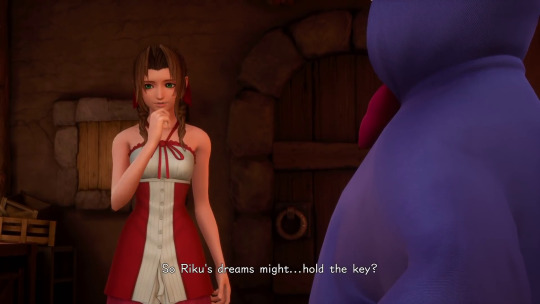

i know ive already posted multiple times about this parallel, but i realized these scenes use almost the exact same wording
auroras dreams led her to prince phillip. fairy godmother believes rikus dreams will lead him to sora.
like. its so one-to-one that if this isnt intentional, WOW. thats a hell of a coincidence!
(hint: its not a coincidence)
#kingdom hearts#soriku#bbs#kh3#re:mind#kh3 spoilers#re:mind spoilers#kh meta#ali's kh meta#[banging pots and pans together] hello!!! HELLO!!!!!
380 notes
·
View notes
Text
Validation- In Which Lurking Turtles Try to Spare Me From Writing a Post by Essentially Plucking My Thoughts Right Out of My Head.
In her incredible post about community, @waitmyturtles posed (and answered) the question:
“Could the ATOTS story have held up WITHOUT Pat and Pran?”
I argue, no, because looking back on the last four episodes, the resolution of that four part story was never supposed to be about Pat and Pran, it was supposed to be about Phupa and Tian. In my opinion, the last four Our Skyy 2 episodes are made for Phupa and Tian.
Hell, it’s not even about Tian to me, this whole story is an arc for Phupa specifically.
I argue, Pat and Pran serve as the vessel by which Phupa is forced to confront his internalized homophobia and must decide whether or not to try to move past it.
This is a bold statement, so let me say right now that I watched ATOTS and Bad Buddy around the same time, and while I deeply enjoyed ATOTS I loved Bad Buddy and initially I found Phupa and Tian to be a rather boring, uncomplicated couple that obviously liked each other and refused to do anything about it, despite me not really seeing any obstacles for them getting together.
But because of now being familiar with Earth’s acting and because of Episode 3, I started to pay more attention to Phupa, made that internalized homophobia observation, and then managed, over the course of the four hours it took me to write that post to go from “You’re boring” to “lmao that’s my fucking guy” in regards to how I looked at Phupa.
And, not to toot my own horn, but I am feeling extremely validated in my read on Phupa and internalized homophobia in yesterday’s post after seeing the final episode of Our Skyy 2 x ATOTS.
@lurkingshan has already shared a lot of her thoughts (which honestly reflect a lot of my own) in regards to how Phupa has learned a lot from his interactions with Pat. @waitmyturtles has shared a lot of her thoughts (which honestly reflect a lot of my own) about how Aof’s stories so often center around queer Asian community. And tumblr has shared in abundance all the happy, lovey-dovey, moments between Pat and Pran and Phupa and Tian.
So I am not going to start there. I am going to start with the supporting evidence of Phupa’s internalized homophobia from Our Skyy 2’s final episode.
The first, when Phupa and Tian are getting dessert and Tian tries to feed him. He looks around anxiously and reminds Tian that they are in public.

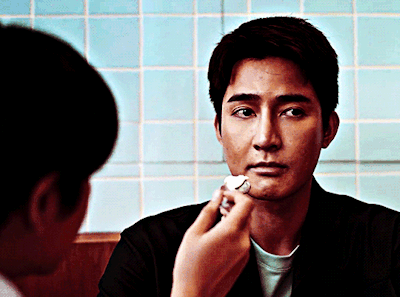
Gifs from @ayan-sukkhapisit
Second, when Phupa and Tian are clothes shopping and Tian leans in to Phupa and says suggestively “You’re so handsome. You got a boyfriend?”

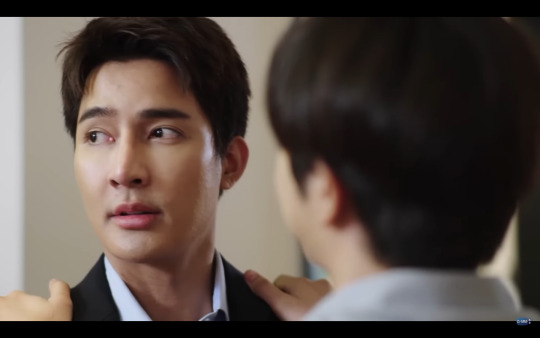
Even when Tian mentions the size of the crowd at the play, Phupa once again looks around anxiously, the weight of the realization that this many people are about to hear the story of his queerness hitting him.
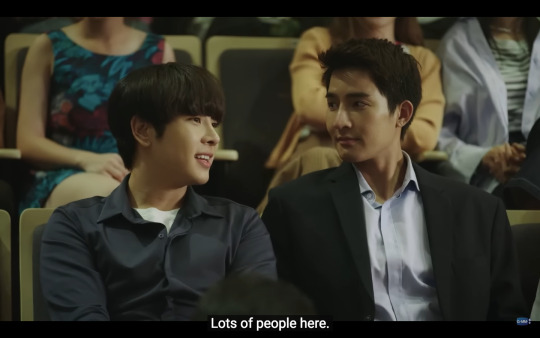

Each of these moments is a point where Phupa’s internalized homophobia is flaring up, but, (and this is crucial) HE PUSHES THROUGH IT.
And that is thanks to Pat and Pran, but especially Pat.
Now (and hear me out here) Pran is fully responsible for getting Phupa to sign the consent form to put on the play. Pran’s moment of brutal honesty where he called out Phupa’s insecurities and confirmed they were also his own, is what led Phupa to realize that these chaotic, loud, and meddling children had a lot more going on than he first thought, and is what led to him confidently making the statement “No one gets us better than these two.”
Pran’s acknowledgement of his own insecurities in his relationship with Pat is enough for Phupa to understand that Pran is desperate to tell this story, his story for a reason.
But Pat? Pat’s continuous, unabashed, unrelenting, and obvious love for his boyfriend and then his continuous, unabashed, unrelenting, and obvious crush on/harassment of Phupa pushes Phupa out of his comfort zone. Pat and Tian may be the people who make the sacrifices in their relationships, but Pat is not Tian. Pat is willing to make sacrifices for Pran, Pat is willing to hide his queer desire for Pran. But Phupa is not Pran. So Phupa is Not Safe. Where Tian is patient and where Tian also tries to minimize/tone down his own feelings when he and Phupa are together in public, Pat sees Phupa, goes “oh that man is hot and repressed and I’m about to make myself his problem,” and then he puts his foot on the gas and does donuts in the parking lot.
At no point in their solo time together does Pat ever let up on Phupa. Thus, Phupa is forced to reconcile with his internalized homophobia, because he is both safe to do so by being in the woods without the rest of the village, and because Pat never stops reminding him that he is queer. Phupa sees how much Pat loves Pran and sees the way Pat and Pran interact with each other, touching knees, running in to each other’s arms, feeding each other, etc. and hears the insecurities Pran has in his relationship with Pat, and how much they mirror his own, and he realizes that he can feel insecure and still have a happy, loving relationship because he has spent hours upon hours of time listening to Pat brag about his boyfriend. The surface fight of who fell in love first is resolved by way of Phupa understanding that Tian can make all these sacrifices and still be madly in love with him. Phupa needed Tian to have fallen in love first so that he can be certain that he didn’t trap Tian here. Tian needed Phupa to have fallen in love first so that he can have security in a relationship where Phupa cannot overcome his insecurities (class, queerness, etc.) to be openly in love with Tian around others.
SO!
The resolution comes when Phupa decides that it is time for him to stop hiding

Gif from @gunsatthaphan
He pushes past his initial discomfort about the level of open affection he is receiving, but eventually relents to Pat’s flirtations and gives him a smile. It is as good as an admission for Pat that Phupa will, in fact, miss him and did, in fact, enjoy their time together.
He openly admires his Tian at the waterfall, he asks to be played with.
He corrects the narrative, and finally does what we all thought he would do, and “steals” the kiss he wanted to steal all those years ago

Gif by @liyazaki
He fucks his boyfriend

Gif by @liyazaki
He woos his boyfriend by rolling up to Bangkok in a car that is almost certainly out of his price range looking hot as hell.
He takes photos of Tian “the food”

Gif from @boyslovesource
And where we saw a momentary flare up of his internalized homophobia in the cafe, because that mentality is not something that is broken in a night, he powers through and allows himself to be fed.
And at the clothing store too, he initially bristles at Tian’s flirtation but very quickly reciprocates it

He signs the contract. He actively and intentionally allows Pran and Pat to tell his story, to celebrate his queerness.
And he comes to see the play. To see the story of he and Tian’s love. The story that until only recently he refused to even finish. And while Tian is surprised that Pat and Pran are playing them, Phupa is not. Partially because he put the stipulations on it, but also because Pat and Pran have chosen to portray the unexpected, but absolutely personality accurate character. Pat is an unexpected Tian if you go off of looks, but Pat serves the role that Tian does in his relationship and therefore is absolutely the perfect choice to play Tian.
(Honestly, thinking about it more, that choice may have also contributed to Phupa’s comment that no one gets them better than those two. Because he sees them acknowledge their own roles in their own relationship based on who they chose to portray.)
Now, something that I also picked up on, but that @chickenstrangers mentions as well is the following:
“We got to see Phupha and Tian's reactions to the play highlighted, seeing that they appreciated the portrayal. We also saw Ink and Pa's reactions, how moved they were by the play and Pat and Pran being able to portray it; how the story was received by other queer people. These special episodes are exploring the tension between needing to hide and wanting to be seen and open, and in the play, both Phupha and Tian, and Pat and Pran got to open a little bit about themselves to others. Even though it is Tian and Phupha's story on stage, Pat and Pran are telling their own as well.”
And it struck me, as I was going back through the episode to pull screen shots that Ink and Pa also watch the mosquito net scene and ask “why does he have to poke his face so close to him?”
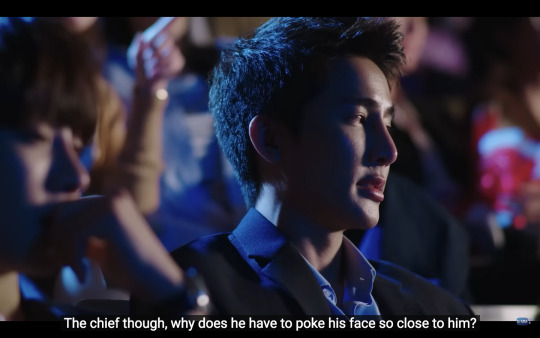
Which indicates to me that Ink and Pa are also expecting a kiss from Phupa and Tian and, not getting one, they wonder why he’s gonna get this close only to not do anything.
Which strikes me as yet another example of the young queer couple not understanding where intimacy can be a struggle for older queers.
Secondarily, Phupa requesting that Pat and Pran portray Phupa and Tian does, in fact, set them up to be openly in love and to have plausible deniability. Phupa doesn’t know that they are going to kiss, and in fact, they were not supposed to. But they do. They get to be open they way the want to be open, the way they wish they could be open. And they get to do it by being vessels for Phupa and Tian’s story.
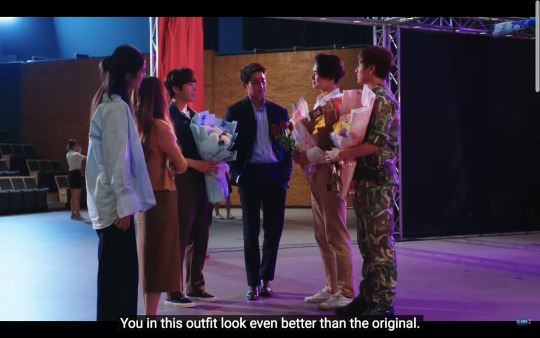
I actually don’t have much to say here in terms of analysis, but dammit if I’m not emo about the Circle of Queers. Look at all them, standing around, being in community with one another. Happy Pride everyone!
AND THEN PHUPA COMES TO FUCKING DINNER!!!!
He lets Tian spend money on him, he finally does the one thing Tian has hoped for all these years, and celebrates his birthday. Comes as his partner, interacts with Tian’s parents.

And is rewarded for it by learning that he had nothing to fear. Tian’s parents are impressed with Phupa’s dedication, the filial nature of his service, the choice he made to move to PPD because his father loved it.
And far more important, Tian’s parents entrust Tian into Phupa’s care.
And, if you want to get in to outdated concepts of queerness, masculinity, husband/wife whatever, then it is also important to acknowledge that Phupa ends the episode getting fucked by his fiance
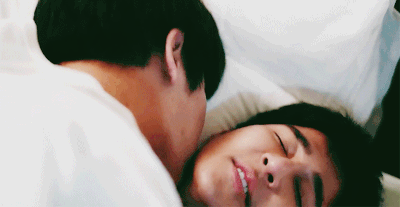
Gif from @gunsatthaphan
And he engages in sex with his partner while his coworker and friend is right outside the door, fully aware of what they are doing. Now, we know from ATOTS that this is not the first time that Yod has heard them having sex. But crucially, in ATOTS, Phupa was not aware that Yod was outside the door.
Now, I know what you are thinking, readers “W-K-A, why did you skip over the most important part of Phupa’s self acceptance journey?”
IT’S BECAUSE I’M SAVING THE BEST FOR LAST OKAY??????? Hush.
The culminating event of this episode, and of the entire four episode arc, is Phupa’s proposal to Tian.
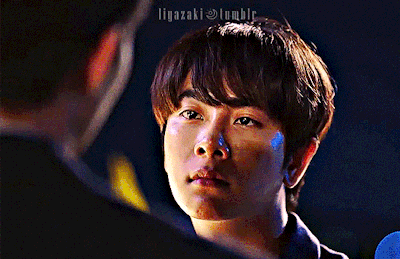


Gifs by @liyazaki
Tian’s part of the fight came from fearing that Phupa wasn’t going to fully committed to him. The constant refusal to go to his birthday, one of the few times a year that Tian sees the rest of his family, serves to make Tian feel like Phupa doesn’t consider himself to be Tian’s family.
Now, back to my argument that this ATOTS story couldn’t have happened without Pat and Pran is that I am not entirely certain that Phupa and Tian were completely aware of what the underlying problem was. And if they were, they certainly weren’t going to talk about it. Tian may still have trudged up the mountain to find Torfun’s diary, and he might still have gotten lost, and Phupa might still have had to rescue him, but Phupa needed to see how a relationship dynamic like his was capable of working.
Back to Phupa’s internalized homophobia, putting a ring on Tian’s finger is both a confirmation to Tian that Phupa is fully and completely committed to him but also a PHYSICAL. VISUAL. INDICATOR OF THEIR RELATIONSHIP.
There is no benefit of the doubt, there is no plausible deniability. No matter where Phupa and Tian go, if they go together the world will know they are a couple. Phupa cannot hide from his queerness walking next to Tian with that ring on Tian’s finger.
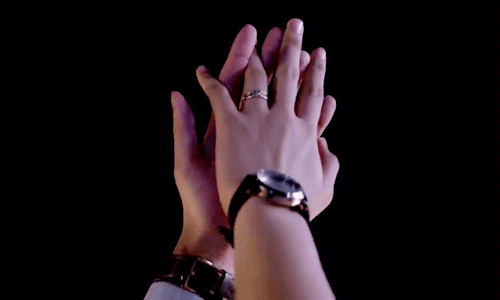
Gif from @thebvbbletea
I know there are many people that wanted more of a stout resolution for Pat and Pran in these episodes. But that wasn’t the point Aof was making. Pat and Pran’s storyline in these episodes feels unresolved because Pat and Pran’s resolution doesn’t come until Episode 12. I understand that these analysis may have gotten me too focused on Phupa, but I don’t know. I can’t shake the feeling that this four part crossover was about Phupa. Pat doesn’t change much, Pran doesn’t change much, because we watched Bad Buddy. Because we have already seen the changes they have made to be with each other. Because there is never going to be balance in Pat and Pran’s relationship as long as Dissaya remains the way she currently is. (I’m taking this from a conversation I had with @shortpplfedup, @bengyio, @waitmyturtles, @lurkingshan, and @ginnymoonbeam). Tian doesn’t change much because he was always the one compromising, because he is committed to Phupa. It is Phupa who goes through the most significant changes.
It is Phupa who had to get comfortable with their relationship being on display in the form of diaries
It is Phupa who had to get comfortable with those diaries showing him being in love with Tian.
It is Phupa who has to get comfortable with Pat’s explicit queerness.
It is Phupa who had to get comfortable with public displays of affection.
PPD is a village removed from most things, there is a vibrant and loving community there. But it means they are removed from overarching society. Phupa needs to see the younger generation of queers being comfortable and confident in their sexuality. Phupa needs to see the younger generation being comfortable and confident in their love. Phupa needs to see that the younger generation isn’t worried about people knowing they are queer, he needs to see them be explicit in their love for each other. No code words, no euphemisms, just a boy and his boyfriend and his boyfriend’s scent. And I think that in order for Phupa to resolve his internalized homophobia, he needed to meet Pat and Pran. I think interacting with Pran made him view Pat and Pran’s relationship as an adult one, granting it infinitely more respect and credibility in his eyes, and interacting with Pat made him realize that it is much safer now to be gay that it once was.
Anyway, I’m going to go cry about “We finally have a thousand stars now” for the rest of forever now, thank you.
#our skyy 2 x bbs x atots#our skyy 2 x bad buddy x a tale of thousand stars#our skyy 2 x a tale of thousand stars#our skyy 2 x bad buddy#our skyy 2#our skyy x 1000 stars#bad buddy#bad buddy the series#a tale of a thousand stars#atots#earthmix#ohmnanon#ohm pawat#nanon korapat#earth pirapat#mix sahaphap#thai bl#gmmtv#our skyy 2 meta#bad buddy meta#atots meta#gay gay gay gay gay#i love gay people#aof noppharnach
277 notes
·
View notes
Text
Pain, Trust, and Separation in Some Asian Dramas (The Second Post In a Series of Utterly Un-scholastic, Highly Personal Big Meta)......
AKA, Turtles Catches Up With Old GMMTV: The Bad Buddy Rewatch Edition, Part 2 -- How Themes of Pain, Trust, and Separation Create Structure and Narrative in Bad Buddy and Other Asian BLs
[The following is a preamble I use for my Old GMMTV Challenge posts, here we go! What’s going on here? After joining Tumblr and discovering Thai BLs through KinnPorsche in 2022, I began watching GMMTV’s new offerings -- and realized that I had a lot of history to catch up on, to appreciate the more recent works that I was delving into. From tropes to BL frameworks, what we’re watching now hails from somewhere, and I’m learning about Thai BL's history through what I’m calling the Old GMMTV Challenge (OGMMTVC). Starting with recommendations from @absolutebl on their post regarding how GMMTV is correcting for its mistakes with its shows today, I’ve made an expansive list to get me through a condensed history of essential/classic/significant Thai BLs produced by GMMTV and many other BL studios. My watchlist, pasted below, lists what I’ve watched and what’s upcoming, along with the reviews I’ve written so far.Today, I offer the second of four posts on Bad Buddy, and the second in a Big Meta series on pain in some Asian dramas, including QLs and/or het romances. I'll look today at how ideas of pain in love, trust in love, and separation of partners/family members creates narrative drive in Bad Buddy and other Asian BLs. THIS IS A LONG POST, caveat emptor.]
Links to the BBS OGMMTVC Meta Series are here: part 1, part 2, part 3a, part 3b, and part 4
Well, after a lot of titles and a chewy preamble (thank you for getting through that, y'all!), I'm here to say that I'm combining my two ongoing meta series into one big ol' post here that I've been dying to write for months. In the course of my watching the shows on the Thailand-based Old GMMTV Challenge watchlist, as well as watching shows from my BL gateway of Japan, I've noticed that the themes of pain and trust in love, along with voluntary or involuntary separation, have been used to create dramatic and narrative structure within Asian dramatic stories to many emotional effects.
I'm celebrating the incredible Thai BL drama that is Bad Buddy in my OGMMTVC series at the moment, and within my Big Meta series on pain in Asian dramas, I examine how themes of pain so very often harken back to artistic, and even traditional, viewpoints of how pain, suffering, and melancholy are natural cultural assumptions within many collectivist Asian societies. In my first Big Meta on pain and suffering in Asian dramas, I wrote that "accepting pain and suffering is a part of the life we decide to live, from an Asian cultural perspective." Suffering is a naturally assumed part of life, a very distinct and identified part of a Buddhist's lived life, and even outside of Buddhism, accepting and living with difficulties of all kinds -- wealth disparities, the struggle for a good education and/or a successful career, the struggle to conform to collectivist familial and/or social expectations, etc. -- are extremely common themes that are unwound on in Asian lives on a minute-to-minute basis. The idea that an Asian must live with pain is often a root of intergenerational trauma, passed along from generation to generation of Asian children-to-adults. The social mores by which Asians are raised and live, to assume what Westerners might call a lack of unconditional parental love and affection, are certainly in part rooted in an assumption that living with pain and without the, say, luxury of turning over one's emotions at any given moment, are an automatic given.
As I've plodded through the OGMMTVC watchlist, I noticed very often that separation of people -- whether those people are lovers, children/parents, or simply just adults within a group -- is often a major narrative turning point in the course of a dramatized relationship. Of course it would be; it's a common trope within the romance genre, for instance.
But I find the separation of people otherwise connected to each other -- and the assumed pain of that separation, and the trust that people may have to return to each other -- particularly fascinating within the realm of Asian dramas, for reasons relating to the assumption of pain and suffering in one's life within Asian cultures that I mentioned above. In other words, the pain of separation, and the trust that one might have that one person will come back to another person -- are givens within the scope of Asian life.
In the following dramas, I note that separation is either a central storytelling point, or is a central focus of side characters:
1) The Thai filmmaker, Aof Noppharnach, has explored separation of people/lovers in many of his shows, including Still 2gether, A Tale of Thousand Stars (in multiple forms), and in Bad Buddy (also in multiple forms, romantic and/or familial).
2) Also from Thailand, Until We Meet Again and I Promised You The Moon are two non-GMMTV dramas in which separation of lovers plays an important concluding narrative role.
3) From Japan, the movie version of Cherry Magic: 30 Years of Virginity Can Make You a Wizard?! captures an important central narrative of separation that leads the franchise's two protagonists, Adachi and Kurosawa, to explore depth in honesty and intimacy that they may not have otherwise achieved in their everyday lives.
The painful separation that occurs in Aof Noppharnach's shows is most often related to the outside forces of life as it needs to be lived -- very often economically -- within or external to Thailand. In Bad Buddy, Pran leaves for Singapore for two years. I'm going to unwind much more on Pran leaving for Singapore in the final installment of my Bad Buddy OGMMTVC meta series, particularly by way of how he can do it, emotionally. But I want to offer a quick note about Pran's departure that the show gives a hint to (despite the pain that we feel in our hearts for Pat's loneliness from Pran, as depicted so beautifully by Ohm Pawat and his silent and longing existence as Pat in the first half of the Bad Buddy series finale). The BBS finale has Pran stating that he'll only be away for two years, and that the pay and the opportunity for an excellent architecture job were better in Singapore. In conversation with the fabulous Thai blogger, @recentadultburnout, RAB mentioned that this is a common occurrence among young Thais -- to move overseas for better job opportunities.
In spite of my heart breaking a bit for Pran being away from Pat when I first learned about his leaving for Singapore -- when RAB put Pran's departure in that context, I had to slap my cheek a bit. Because! I'm a child of Asian immigrants. Separation from family for better economic opportunities is a HUGE part of our paradigm of life between continents. As my Asia-based uncle, my mother's brother, once put it, in regards to my mother: "one of the children in our families always had to move away." For my mother's family, it was my mom who shipped off. Besides individuals seeking better economic opportunities for themselves, the economies of many Asian countries are dependent on the reception of remittances from overseas family members sending money back to their home countries, as my mom did for years; the Philippines is particularly notable for having a nearly 9% contribution from overseas remittances to its gross domestic product. In other words? The separation of loved ones is literally built into the financial frameworks of many Asian nations.
The separation of children or partners to overseas locales for the sake of better salaries and/or opportunities is simply a more assumed part of the cultural paradigm, I'd argue, in Asia than in the West. Family separations for jobs are extremely common in Asia; in the West, I'm not sure they are as assumed, especially for extensive separations, as the value placed on keeping a family unit together for cultural or spiritual reasons seems to be more a part of the Western fabric of life (despite our high rate of divorce).
We see an even more permanent economic separation happen in Still 2gether between two side characters -- Type, played by Toptap Jirakit, who is Tine's (Win Metawin) brother, and Man (Mike Chinnarat), who is Sarawat's (Bright Vachiwarit) friend. Man chased after Type during the first 2gether season; in Still 2gether, they're navigating their committed relationship, as Type contemplates, then accepts, a permanent job offer in Phuket, hours away from their home base in Bangkok.
As @lurkingshan put it, I might be the only person on the planet contemplating Type's and Man's relationship (lmao, it do be true), but I found Type's last conversation with Man, on the beach, to be particularly direct and moving for someone who has no immediate plans to move back to the side of the person he's dating.

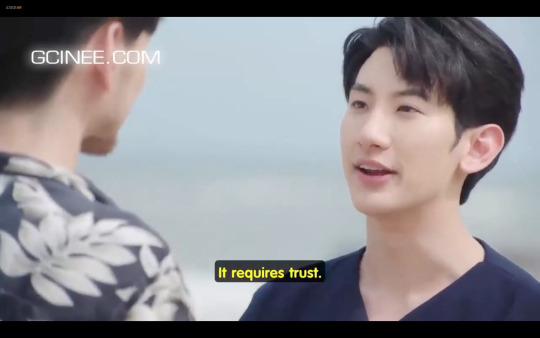

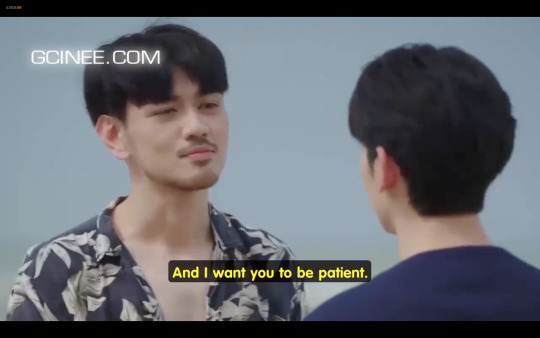

I think about this scene against the structure of the short series that is Still 2gether, which is centered around the protagonists of Sarawat and Tine being temporarily separated as they prepare to compete in a university-wide tournament. Sarawat has the most lovely contemplation on love during this separation, and even Aof Noppharnach himself admits that the glance that Sarawat and Tine give to each other as they pass each other in the lead-up to the ultimate tournament is his favorite scene he's ever filmed (!!!) (and that scene is sooooo reminiscent of Pran's and Pat's pinky-hold after their public "break-up").
In other words: Still 2gether is ALL about separation, and contemplating the strength of love relationships in the face of those separations. While Sarawat and Tine will get back together, after that tournament -- Type and Man are separated for the foreseeable future. There is no end indicated to the patience that Type wants from Man. The conversation is just, THERE, and hanging -- there's an acknowledgment that long-distance relationships are tough, but Type isn't offering to quit his job and move back to Bangkok. Instead, Type and Man are left to accept the reality that there is no end in sight to their separation.
And I think this was incredibly bold of Aof Noppharnach to include in a GMMTV BL that otherwise ended happily for Tine and Sarawat, the main protagonists. What I admire about Aof's works are these sly inclusions of open-ended, sometimes melancholy non-resolutions, either for his main or his support characters, that leave us as viewers often slightly unsatisfied or unfulfilled. He did this in particular with the character of Aof in Gay OK Bangkok, a web series that he screenwrote in 2016; and many might say that Pran being away in Singapore is also not the most satisfying of endings for our beloved PatPran in Bad Buddy. To me, these decisions to do this artistically are just incredibly reminiscent, again, of the kind of pain that we as Asians have been culturally attuned to accept, for the sake of economics, and/or for the sake of the betterment of our loved ones.
Besides economic separations in Aof Noppharnach's works, we also have separations related to family demands and desires. In A Tale of Thousand Stars and Our Skyy 2 x A Tale of Thousand Stars, we see Tian leaving Phupha's side for two years to study for a graduate degree at Tian's mom's insistence; and we see Phupha refusing to join Tian, after Tian has graduated and moved back to Pha Pun Dao, on trips Tian takes back to Bangkok to celebrate his birthday with his parents.
When I rewatched ATOTS earlier this year, I noted that both Phupha and Tian were remarkably bad communicators throughout the original series -- and I posited that, in large part, their terrible communication was borne out by way of the both of them being raised in traditionally masculine Asian households that seemed to not allow for leeway regarding emotional revelations. BOTH Phupha and Tian were expected and intended to follow in the footsteps and demands of their family members. To the end of the ATOTS storyline in Our Skyy 2, Phupha brings up his parents -- and he hears what he has been wanting to confirm from Tian's parents, in their desire to have Phupha take care of Tian for the rest of their lives.
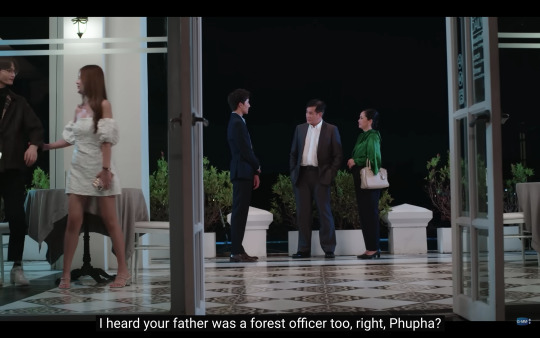


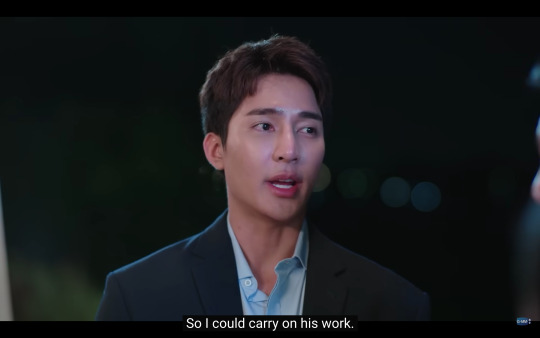

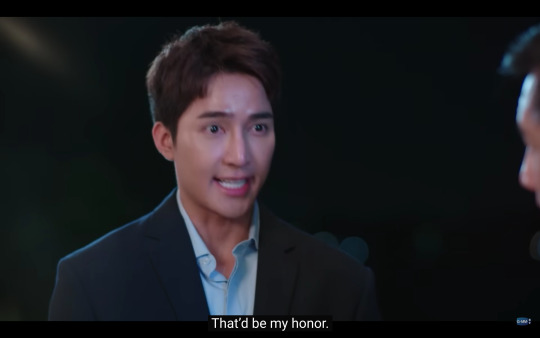
Phupha in particular needed to have multiple gateways opened to him, vis à vis Tian's family, in order to properly and openly confirm his permanent love and commitment to Tian. If Phupha didn't have that? He was willing to be separated from Tian, either temporarily, or at length. Phupha needed a kind of culturally accepting door opened to him -- as a man raised in what we assume to be a rural and traditional environment that may very well have not allowed for a gay man to live openly and honestly. Phupha indeed follows in his father's footsteps, to the extent of never leaving Pha Pun Dao, and demanded that he have Tian's family's approval before making the final commitment to Tian to love Tian forever.
I find the cultural nuances of nuclear family separation, or separation encouraged by nuclear family, to be particularly heartbreaking in many of Aof Noppharnach's works. We know that Jim and Jam, brother and sister in Moonlight Chicken, ran away from their Isan hometown as youths to find their lives in Pattaya, where we meet them in the context of that show. But separation either from nuclear family, or more impactfully, done by nuclear family, is most evident in Bad Buddy.
Besides Pran voluntarily leaving for Singapore, we know that Pran has been involuntarily separated from Pat before -- when Pran was transferred to a boarding school in 10th grade by his mother, Dissaya. Before that transfer, Pran and Pat were technically "separated" by their parents in so far as they were not supposed to become friends -- all while competing heavily against each other in every category of life.
That boarding school transfer? That wasn't just separating Pran from Pat. What I found remarkable about that separation during my recent BBS rewatches is that Dissaya HERSELF chose to be physically separated from her own son, for the sake of her rivalry with Pat's father, Ming.
I'm thinking about this particularly from the words she used with Pran as they sat at breakfast together before Pran started his second year at university, when Dissaya said that Pran could date anyone, men or women, as long as he "didn't date [the next door kid]."
My interpretation of that perspective is that Dissaya did not want Pran to relieve the heartbreak that she herself experienced when she was close with Ming in her teenage years.
In other words: she chose to send her son away in the face of her ongoing, lifelong fear that Ming and his family would once again wreak havoc on her and her clan.
In the continuation of the intergenerational trauma wrought upon Pat and Pran by their parents -- as a mother myself, this seems to be particularly egregious. Dissaya would have rather had her son AWAY FROM HER, than to contemplate her son even being WITHIN physical proximity to Pat in the context of her hatred of Pat's father, Ming, and the fear that she had that the Jindapats would negatively influence the Siridechawats again.
(The wonderful @telomeke reminded me, in conversation on this topic, that the first question Dissaya asks Pran, after learning about the first faculty fight in episode 1 when Pran re-encounters Pat for the very first time, was, "Did he hurt you, Pran?" Dissaya cannot bear to allow the Jindapats to hurt her son, or her family, ever again.)
I wrote in my first Big Meta on pain and suffering that Asian parenting expectations and mores are far more conditional than they are in the West, as parenting mores in the West are centered around unquestioned and unconditional love from parents to children. So much of Bad Buddy meta out there focuses on the internal experiences of Pran and Pat. When I sat back to think about Dissaya making the decision for herself to be separated from her son for years -- and then to also contemplate pulling Pran FROM COLLEGE when she learns that Pat goes to Pran's university -- I mean. We know Dissaya and Ming both tried their best to embody their hatred of each other into their children. But Dissaya takes it a couple steps further, by attempting to literally control Pran's physical existence vis à vis Pat, which -- and I'm going to sound like a judgmental Westerner here, even as an Asian -- strikes me as out of line by way of just pure emotional projection onto one's children.
When Pran goes to Singapore, at the end of the series, it's out of his own volition. Again, I'll write more about this at the end of my BBS OGMMTVC meta series. But what he experienced by ways of many TYPES of separation from Pat throughout his life -- competitively, emotionally, and then physically -- are extensive. He was physically separated from Pat by Dissaya. He was theoretically "separated" from Pat emotionally, by being discouraged in having a friendship with Pat. He is physically separated from Pat *again* when he goes to Singapore. And I posit later in this piece that Pat and Pran had another theoretical "separation" when they are pretending to be broken up throughout the course of their relationship.
When I think about what teenage Pran must have felt to be *physically sent away* -- BY and FROM his own family, for their sake of his family's desires to avoid ANOTHER family -- it explains a hell of a lot more about Pran's tendency to dissociate, particularly during stressful times. (We see this when he's alone at the demolished bus stop, and cutely in Our Skyy 2, as Pat encourages a grumpy Pran to go to Pha Pun Dao.)
And where Pat balanced Pran out -- where Pat could offer the kind of companionship, and relaxed and equitable communication that Pran had never had with his family -- was where Pran could finally experience truly open and SAFE love from and with another person, another person who wouldn't *send him away* if Pran didn't play by their rules. Instead, Pat fought by Pran's side, and Pran was willing to fight, too, and they remained together, and safe in their love and trust.
Whew. Dissaya separating Pran from his own family, from herself -- to leave him alone at boarding school -- seriously punches me in the gut, especially as a mother myself. I'm thinking about a teenager, on the cusp of adulthood, alone to contemplate his unending love for Pat, and I'm like.... I wouldn't leave a kid alone like that for a moment. But for Dissaya, her husband, and their pride? It seemed to be a worthwhile decision in that moment. A decision that we know would blow up in their faces in episode 10 of Bad Buddy.
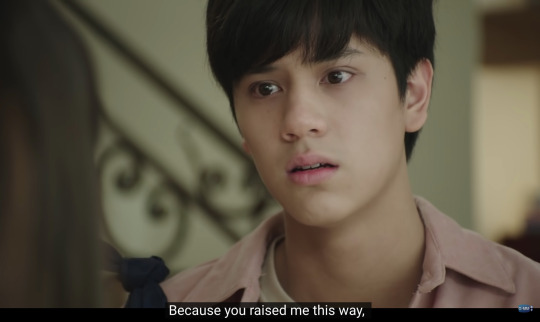

In Pran's first separation from Pat -- Pran did not have personal agency. He did have agency later on, as he moved to Singapore, which again, I'll contemplate in a further meta.
Two instances where I was impressed by protagonists leveraging their agency vis à vis temporary separations from their partners was in Until We Meet Again and in I Promised You The Moon.
UWMA's Pharm was first and foremost presented as a blushing maiden. HOWEVER: Pharm demonstrated quite a bit of sexual agency early in the series. He was forward in his crush on Dean. He contemplated openly being gay. And he wasn't afraid to push Dean away when Dean was moving too fast sexually.
At the end of the series, after Dean and Pharm have resolved their spiritual connection vis à vis the embodied spirits of Korn and Intouch meeting once more -- Pharm wants to know if the love between him and Dean is real, and independent of the influence of the spirits of Korn and Intouch. So: Pharm asks for a break.
Throughout UWMA, Dean is the obvious seme, and Pharm is the blushing uke. I squealed in DELIGHT when I first watched Pharm asking for the break. Yes, Pharm loved Dean -- and what I saw in Pharm's asking for a temporary separation was truly out of that love, to confirm between the both of them that their relationship was very much indeed a forever relationship. God, I get chills thinking about it: Pharm was safe enough in his sphere with Dean to ask for and to GET the agency-driven space that HE NEEDED to feel fully confident in the relationship. That was a risky move that paid off for the two guys in dividends in the end. Dean had no choice but to say yes there.
The fabulous Oh-aew in I Promised You The Moon goes even further than Pharm. He fucking breaks up with Teh! After Teh cheated on Oh-aew! YES, HOMEY, YES! No wibbling on Oh-aew's end. Oh-aew was devastated, yes. But he knew he had to have Teh out of his life in that moment, for the sake of Oh-aew's own happiness, growth, and development. He even rejects Teh's reach-out at the end of their college careers.
What stuck me as so golden about the ending of IPYTM was that that break-up wasn't actually presented as temporary. They were apart for OVER A YEAR (thank you kindly to @shortpplfedup for the temporal fact-check!). Oh-aew held his ground. He needed his time and space. He needed to grow! And he valued that, individually.
I'm celebrating these two instances of agency-driven separations because of the style of their intention vis à vis the protagonists asking for, needing, and leveraging these separations. With the economic and involuntary separations I talked about earlier -- it's like there was a higher need, whether it was for money, a better career opportunity, fear, or selfishness on the part of a family to create the separation.
With Pharm and Oh-aew: the separations they demanded were purely personal and for their own growth. We know now that Pharm and Oh-aew get their endings with their partners. Pharm has a purely happy ending with Dean in Between Us. Oh-aew's ending with Teh is open-ended -- we don't know what chaos Teh will wreak next -- but at least we know they're navigating that chaos together again.
The last drama I wanted to take a look at regarding pain, trust, and separation is the fabulous movie continuation of Cherry Magic: 30 Years of Virginity Will Make You a Wizard?! (I always love writing ?! whenever I talk about Cherry Magic, lol).
The central separation in the movie of the two protagonists, Adachi and Kurosawa, comes about when Adachi is transferred to Nagasaki for work. As @neuroticbookworm and @lurkingshan can attest to: a Western viewer of Japanese BLs will often find themselves screaming to a screen, "JUST TALK ALREADY!," and a uniquely common aspect of Japanese doramas is that so much of communication in Japanese culture is silent, unsaid, kept internal by collectivist social pressures to not make waves with another person -- which automatically creates ongoing questions of trust between partners. When Adachi (Akaso Eiji) shares with Kurosawa (Machida Keita) that Adachi will be moving, Kurosawa shares in words that he's happy for Adachi, but through very simple body language, communicates that he is feeling otherwise.
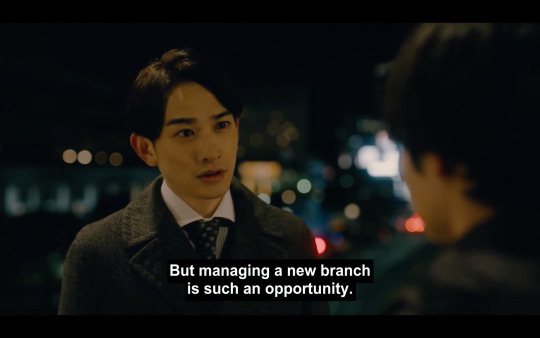
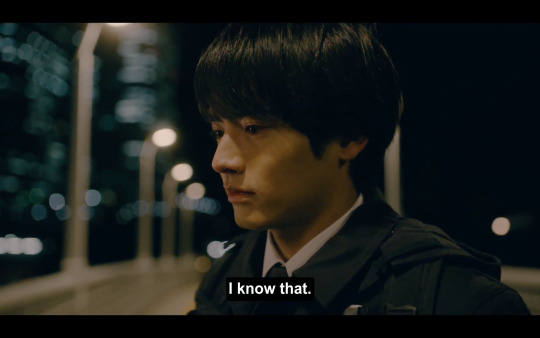

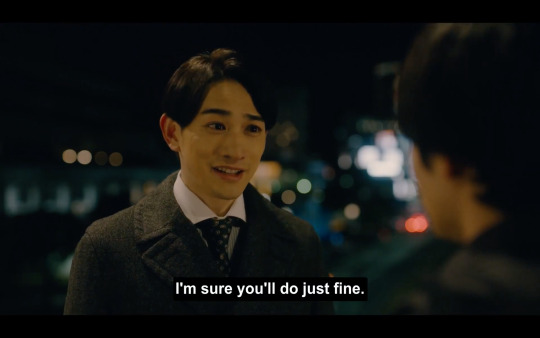
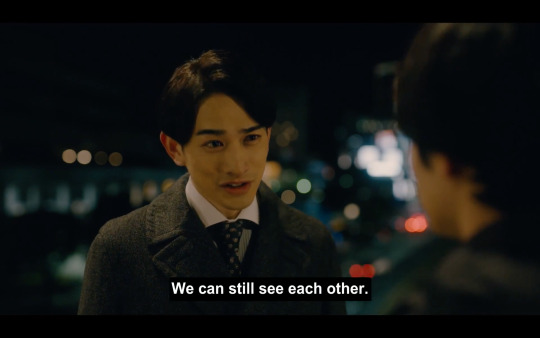


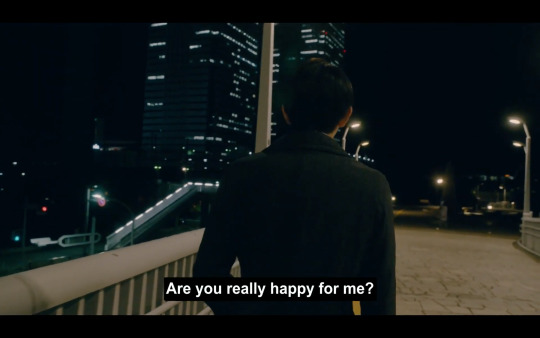
Later in the movie, Adachi gets into an accident in Nagasaki, and Kurosawa rushes to be by Adachi's side. Kurosawa is clearly traumatized. And Kurosawa finally reveals his feelings about the entire situation -- a rare display of direct emotional confession.



We think that Adachi moved to Nagasaki for this job opportunity -- separating himself from the incredibly devoted and head-over-heels-in-love-with-Adachi Kurosawa. Adachi knows well enough that Kurosawa is suffering in this separation. But later in the movie, after Adachi has moved back with Kurosawa, do we learn Adachi's true intentions. Adachi wants to make himself invaluable at work -- so that Adachi's and Kurosawa's shared company will not separate them if the company finds out about their relationship.


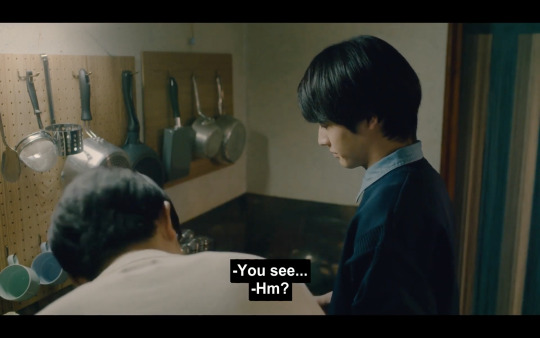


This particular conversation between Adachi and Kurosawa -- after their separation, after they've moved in together -- is a huge turning point in the movie for Adachi, who had usually been the reluctant uke in their relationship prior to this moment. In this conversation, Adachi expresses his fear that outside forces will eventually separate them, and he wants to do what he can to ensure the safety of their relationship.
To me, this is incredibly reminiscent of the compromises Pran and Pat make in Bad Buddy to keep their relationship secret -- another theoretical "separation" -- from their parents for the health, safety, and viability of their relationship.
As well, this conversation between Adachi and Kurosawa moves forward into Adachi's desire to come out to their families. He was inspired by the immediate aftermath of the accident, in which Kurosawa was the last person to find out that Adachi had gotten hurt -- only after Adachi's family and company were notified.
The nuances of this separation between Adachi and Kurosawa -- and what the separation LED TO, which was an eventual and permanent commitment between Adachi and Kurosawa -- are incredibly layered. Adachi made an economic separation from Kurosawa. But it was also rooted in his desire to acclimate his company to his company's dependence on Adachi, so that the company would choose Adachi's contribution to the company over the potentially taboo reality of his same-sex relationship with a colleague in Kurosawa. In other words: he wanted to leverage the separation and his work performance upon his return, to render the company no choice in choosing Adachi's economic performance over his personal and private choices.
(One insight into Japanese culture is that for decades, Japanese corporations have wanted their employees to be married, to complete a seamless connection between household and "office" families. The Japanese BL Kinou Nani Tabeta?/What Did You Eat Yesterday? makes reference to the fact that the main protagonist, Shiro, becomes an independent lawyer because, as a gay man, he may have been pressured to take a wife in another, more group-oriented corporate setting.)
AND, following this, Adachi wanted to come out to his and Kurosawa's families, to also acclimate them to their relationship, so that their families would also not threaten the sanctity and safety of their relationship. And his gamble worked -- and their families accepted them, and they were able to make a permanent commitment to each other.
Without a strategically economic separation, Adachi and Kurosawa could not have achieved key moments of communication that led to their ability to find safety in their external environments, and make a personal and private permanent commitment to each other. The separation to Nagasaki was Adachi's lever to move their relationship forward.
It's so nuanced, so layered, and so strategic on Adachi's end, to use the work separation and his commitment to his company as such a motivator to propel his relationship forward and permanently with Kurosawa -- especially vis à vis the unique nuances of spoken and unspoken communication in Japanese society, which are remarkably different than the styles of communication we see in Thai dramas.
In Pran's and Pat's conclusion in the Thailand of Bad Buddy, they go in the opposite direction: for the sanctity and safety of their relationship, they act out a break-up scenario (with Dissaya telling Pran, "come back to your family," ha), and keep their committed relationship a secret. And this happens *two years* before the context of an actual, physical separation when Pran decides to move to Singapore after graduation.
It's a bit of a switcheroo from what we'd expect by way of open vs. closed communication between Japan and Thailand. But both scenarios, from Cherry Magic to Bad Buddy, work brilliantly well to ensure that all relationships are safe and solidified.
I'm not sure that I can say, globally, that separation from one's nuclear family, or separation from a partner, are common occurrences in manifested everyday reality. As I mentioned before, the economies of many countries are dependent on the physical separation of their citizens to other locales to send back monetary remittances. But more often than not -- when partners are partnered, they tend to want to stay by each other's sides.
I love that many Asian dramas do not shy away from the many realities as to why partners or children may be voluntarily or involuntarily separated from loved ones. Our beloved dramas show us the devastation of involuntary separations, as rendered by Dissaya unto Pran. We see that economic separations can actually LEAD to a solidifying of relationships in the case of Adachi and Kurosawa. We see that family-motivated separations, in the cause of Phupha and Tian, simply needed the investment of time for their relationship to reach a point of comfortable commitment. We see that agency-driven separations by Pharm and Oh-aew can lead to emotional clarity. And, we see that theoretical, secret-kept "separations," of the kind that Pat and Pran created for themselves, to protect their relationship, were risks worth taking, simply for them to be together and happy.
Pain and happiness are not emotions independent of each other. At least in the eyes of my Asian cultures, human beings embody all emotions, all the time. Humans are certainly primed, internally and socially, to seek happiness and balance. But as I've posited here in this post -- is there pleasure without pain? The pain of separation, the trust that partners and family members can learn from each other through separation, and the lessons and communicative ability to solidify relationships after the obstacles of separation, are all themes of life that, I think, are worth unwinding on, in glorious emotional detail. And I love that our beloved Asian dramas do not shy away from these examinations.
(Tagging @dribs-and-drabbles and @solitaryandwandering by request! If you'd like to be tagged, please let me know!)
[Well, this one was a doozy -- if you got through it all, I thank you! Next up, next week, is another post I've been dying to write for months. I had the opportunity to engage in lengthy conversation with a number of FABULOUS Asian Tumblr bloggers, all of us Bad Buddy stans, to reflect on our experiences as Asian reviewers watching BBS and to talk about what we related to. I have a list, a WHOLE LIST! of themes to expound on. I'm calling it Asian Cultural Touchpoints Within Bad Buddy. And I may need to split it into two posts, because there's a lot to talk about. Join me and my friends next week in our continued Bad Buddy brain-rot sesh!
Here is the status of the Old GMMTV Challenge watchlist. Tumblr's web editor loves to jack with this list; please head on over to this link for the very latest updates!
1) The Love of Siam (2007) (movie) (review here)
2) My Bromance (2014) (movie) (review here)
3) Love Sick and Love Sick 2 (2014 and 2015) (review here)
4) Gay OK Bangkok Season 1 (2016) (a non-BL queer series directed by Jojo Tichakorn and written by Aof Noppharnach) (review here)
5) Make It Right (2016) (review here)
6) SOTUS (2016-2017) (review here)
7) Gay OK Bangkok Season 2 (2017) (a non-BL queer series directed by Jojo Tichakorn and written by Aof Noppharnach) (review here)
8) Make It Right 2 (2017) (review here)
9) Together With Me (2017) (review here)
10) SOTUS S/Our Skyy x SOTUS (2017-2018) (review here)
11) Love By Chance (2018) (review here)
12) Kiss Me Again: PeteKao cuts (2018) (no review)
13) He’s Coming To Me (2019) (review here)
14) Dark Blue Kiss (2019) and Our Skyy x Kiss Me Again (2018) (review here)
15) TharnType (2019-2020) (review here)
16) Senior Secret Love: Puppy Honey (OffGun BL cuts) (2016 and 2017) (no review)
17) Theory of Love (2019) (review here)
18) 3 Will Be Free (2019) (a non-BL and an important harbinger of things to come in 2019 and beyond re: Jojo Tichakorn pushing queer content in non-BLs) (review here)
19) Dew the Movie (2019) (review here)
20) Until We Meet Again (2019-2020) (review here) (and notes on my UWMA rewatch here)
21) 2gether (2020) and Still 2gether (2020) (review here)
22) I Told Sunset About You (2020) (review here)
23) YYY (2020, out of chronological order) (review here)
24) Manner of Death (2020-2021) (not a true BL, but a MaxTul queer/gay romance set within a genre-based show that likely influenced Not Me and KinnPorsche) (review here)
25) A Tale of Thousand Stars (2021) (review here)
26) A Tale of Thousand Stars (2021) OGMMTVC Fastest Rewatch Known To Humankind For The Sake Of Rewatching Our Skyy 2 x BBS x ATOTS (re-review here)
27) Lovely Writer (2021) (review here)
28) Last Twilight in Phuket (2021) (the mini-special before IPYTM) (review here)
29) I Promised You the Moon (2021) (review here)
30) Not Me (2021-2022) (review here)
31) Bad Buddy (2021-2022) (thesis here)
32) 55:15 Never Too Late (2021-2022) (not a BL, but a GMMTV drama that features a macro BL storyline about shipper culture and the BL industry) (review here)
33) Bad Buddy (2021-2022) and Our Skyy 2 x BBS x ATOTS (2023) OGMMTVC Rewatch (The BBS OGMMTVC Meta Series is ongoing: preamble here, part 1 here, and more reviews to come)
34) Secret Crush On You (2022) [watching for Cheewin’s trajectory of studying queer joy from Make It Right (high school), to SCOY (college), to Bed Friend (working adults)] (watching)
35) KinnPorsche (2022) (tag here)
36) KinnPorsche (2022) OGMMTVC Fastest Rewatch Known To Humankind For the Sake of Re-Analyzing the KP Cultural Zeitgeist
37) The Eclipse (2022) (tag here)
38) The Eclipse OGMMTVC Rewatch For the Sake of Re-Analyzing an Politics-Focused Show After Not Me
39) GAP (2022-2023) (Thailand’s first GL)
40) My School President (2022-2023) and Our Skyy 2 x My School President (2023)
41) Moonlight Chicken (2023) (tag here)
42) Bed Friend (2023) (tag here)
43) Be My Favorite (2023) (tag here)
44) Wedding Plan (2023)
45) Only Friends (2023) (tag here)]
#bad buddy#bad buddy the series#bad buddy meta#bad buddy the series meta#backaof noppharnach#aof noppharnach#nanon korapat#ohm pawat#ohmnanon#patpran#pran x pat#pat x pran#still 2gether#a tale of thousand stars#atots#our skyy 2 x bad buddy x a tale of thousand stars#cherry magic#cherry magic the movie#until we meet again#i promised you the moon#i told sunset about you#ipytm#itsay#moonlight chicken#the bbs ogmmtvc meta series#turtles catches up with the essential bls#turtles catches up with thai bls#turtles catches up with old gmmtv#the old gmmtv challenge#ogmmtvc
74 notes
·
View notes
Text

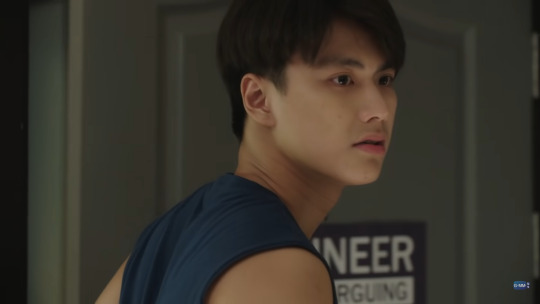


Pat's father speaks disparagingly of Pran and his family while Pran is trapped under the bed hiding. Pat tries to get him to stop talking and defend Pran's family ("They're not that bad"), then tries to hustle his dad out as fast as possible, turning back to reassure Pran before he's even gotten the door all the way closed.
And Pran knows Pat is going to try to comfort him, so before Pat has said more than a syllable Pran's already telling him to forget it, that he's sorry for making things harder.
Just... they've NEVER been enemies. Pat never wants Pran to hurt (and vice versa), and Pran knows Pat never wants him to hurt (and vice versa). They know each other so well, they are the only people who know this experience. They've been in it, together, from the beginning.
Pat says at the beach he could never hate Pran because he knows he's been through the same.
#this bad buddy rewatch is kicking my butt folks. every moment is so steeped in melancholy#bb#bb meta#bb images#ranch thoughts
93 notes
·
View notes
Text



Silver Swarovski rings from the BlazBlue 10th Anniversary Celebration
Sold for ¥13,000 or roughly $90 (USD)
Released in 2019. As of now, the rings are no longer being manufactured and are presumably unavailable anywhere online.
Swarovski crystals are made of a material known as lead glass, largely made of quartz sand. From what I can tell, all of the gems featured in these rings are made of the same primary material, colored differently. I'll be analyzing the colors of the gems below.
Disclaimer; I am NOT at ALL studied in gems or jewelry, so this is yet another lesson I'm learning because of BlazBlue. As a beginner relying on an online-search crash-course, I may mess up the information I'm trying to share. If anyone here knows more about gems and can offer their thoughts, I would love to hear them!
Ragna = Light Siam

Light Siam is often ascribed to particular rubies or garnets, describing their vibrant reds. The color is associated with passion, energy, and strength- some of Ragna's prominent character traits! They're also said to suggest a fiery personality, again fitting for our dear Bloodedge.
Some of the gemstone guides I read while researching this claimed that an integral note of the Siam color is the blue undertone of the gem. As one blog described, without the that blue, "they just aren't Siam the way Siam should be!" I don't think I'm well trained enough to see the difference, but I thought this was a really cool connection to Ragna's relationship with the Azure.
Hazama = Fern Green

The Fern Green we see in Hazama's crystal is also sometimes used to describe certain variant of Quartz. The color is considered quite classy, and is often paired in a piece with Light Siam gems. It's considered a nice transitional color between the Peridot we see assigned to Noel, and the Emerald assigned to Terumi.
Professionals also ascribe themes of renewal, calmness, and prosperity to the color. At first glance this seems a little too peaceful for who Hazama is under the surface, but I think it captures where he differs from Terumi well.
Hibiki = Purple Velvet
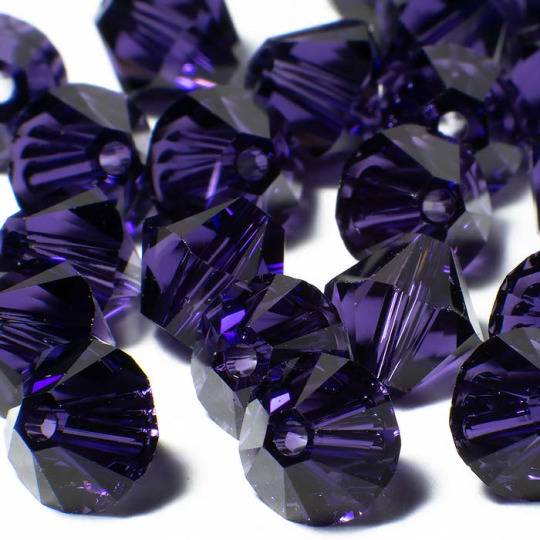
Unlike the previous two colors that are associated with particular gemstones, I can't find any instance of Purple Velvet being used to describe a well known gem. Instead, it's framed in opposition to the well known Amethyst, described as being notably darker, with a more blue undertone than the red you see in Amethyst.
The color is set to give a sense of elegance, sophistication, and poise to the pieces it features in. As with any purple shade, it's highly suggestive of nobility.
Some websites suggest pairing it specifically with Fern Green, an interesting note as we see Hibiki and Hazama framed against one another in Central Fiction.
Terumi = Emerald

Emerald is one of the four precious stones. Made of the mineral Beryl, the gem itself is considerably fragile and prone to breaking. Glass canon, anyone?
Though Terumi's gem here isn't a real emerald, but more crystal, like the others. Still, I find it interesting that out of all ten characters, only he and Nu make it into that exclusive precious gem category. It's also quite fitting that Terumi's gem is a fake passing itself off as something else, isn't it?
Like the gem that is its namesake, the color Emerald symbolizes power, intensity, and confidence.
Jin = Majestic Blue

Majestic Blue is a color sometimes likened to deep seas or raging rivers, but most often, it's described as capturing the night sky. The color chosen for our Duodecim heir is a popular choice for more formal or even luxury items. It's said to represent themes of strength, nobility, and dignity. Some reviewers suggest pairing it with Emerald.
As strange as it sounds to someone outside the jewelry community (me) this color, Majestic Blue, was actually a new invention by Swarovski in 2019, the year these anniversary rings were produced! It's the youngest color in the set! At the time of release, it was the most visually striking blue in Swarovski's entire lineup.
Mai = Fuchsia
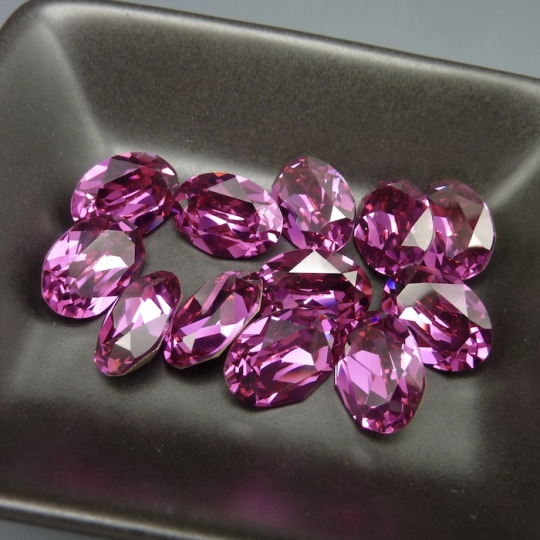
Swarovski's Fuschia is a pink with blue undertones, echoing Mai's genderqueer identity- she now stands proudly as a woman, but her identity as a man is still a cherished part of her at the root of who she is today.
These gems are popular in the the fashion industry, particularly for women. The hue is considered energetic and exciting, described as bright, bold, and striking. Though Mai still has her moments of doubt, I feel these words describe her true self well. For me, they really bring her playstyle to mind too.
The color is named after the Fuschia plant and its flowers- the names seen in Mai's moveset also carry a floral theme. Suggested pairs include the Light Sapphire we'll later see in Nu's gem and the Majestic Blue featured in Jin's.
Celica = Tangerine
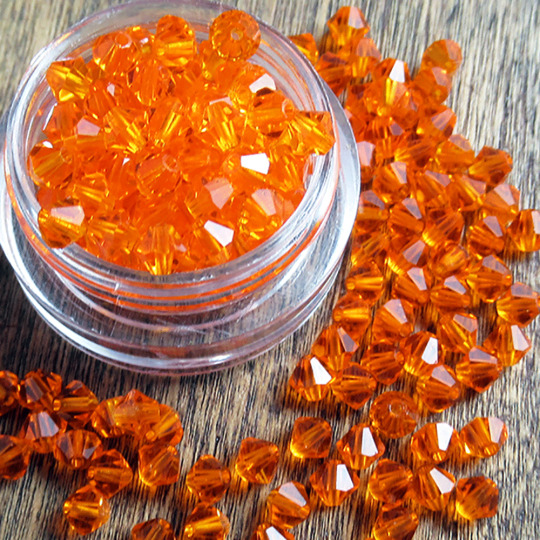
Tangerine was probably the most difficult color for me to research. I looked through several articles, and most people had nothing to say about the color itself. The only thing people talked about was that it was being discontinued by Swarovski. I... guess that's fitting for Ms. Chrono Phantasma?
After a lot of looking, I was finally able to find some reviewers discussing the color itself. Tangerine is a color that brings warmth to the pieces it features in, and is suggested to be paired with Jin's Majestic Blue, among other colors. It was considered a gorgeous and bright color that some reviewers said had an understated depth that paired wonderfully with other stones. It was a strong pick for spring designs.
Noel = Peridot
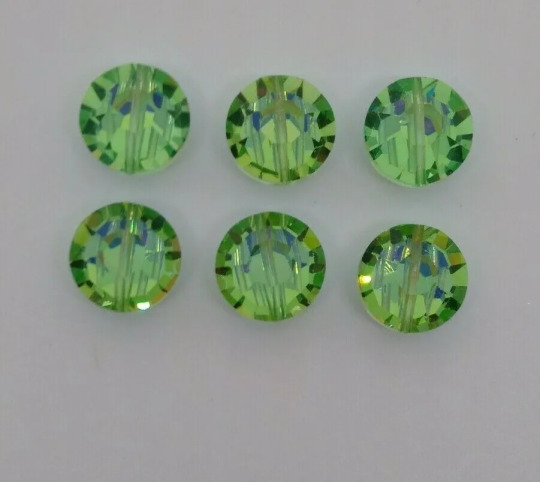
Peridot is another example of a crystal color named after a specific gemstone. True Peridot is made of the mineral Olivine, and is distinct as one of the few gemstones that can only be found in a single color. It is sometimes mistakenly identified as the same gemstone as Emerald, though the two are entirely distinct.
The Peridot color is widely popular in design work, featured in a number of different scenes, from the typical fashion scene to being surprisingly and distinctly popular in dance costume designs.
The color is considered strongly unique. It's said to carry themes of tranquility and balance, as well as connotations of renewal and growth.
Nu-13 = Light Sapphire

Light Sapphire takes its name from the precious gem Sapphire, made of the mineral Corundum. Though most famously blue, it naturally occurs in a variety of colors, including the yellow we may associate with Lambda and the purple we may associate with Gamma. While often used in fashion and jewelry, they also feature in a lot of electronic goods, such as infrared optical components, electronic wafers, and certain integrated circuits. They have a lot of practical uses!
Of course, Nu's gem is no sapphire- it only takes inspiration from the color. It doesn't even match the gem's natural shades. As a color, Light Sapphire is considered soft and delicate, reminiscent of Nu's true state under all the violent mania that both Noel and Ragna call attention to at various points in the series. This is an interesting contrast to its namesake gem, as Sapphire is considerably hard and durable.
The light color is suggestive of clear, breezy days and sunny skies. It is often featured in jewelry alongside Aquamarine, Es's color.
Es = Aquamarine
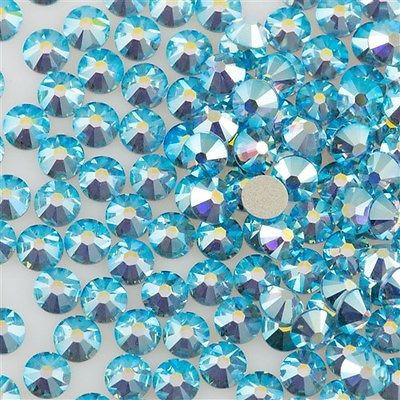
Like Terumi's Emerald, true Aquamarine is made up of the mineral Beryl. Interestingly, it is unique in the distinction of not only being its own gem, but also being used as a descriptor for the colors of other gems; Aquamarine Emerald, Aquamarine Sapphire, and Aquamarine Chrysolite (Peridot) are all common terms to used by gemologists to reference specific variants of their distinctive gems.
As a color, Aquamarine is suggestive of deep oceans, not unlike the Boundary. It's said to be soft and delicate, like Es's appearance, but charming with a brisk sense of clarity. Some say it has a soothing effect, calming one's mind and their emotions.
#blazblue#blazblue central fiction#bbcf#celica a mercury#hibiki kohaku#nu 13#hazama#ragna the bloodedge#yuuki terumi#jin kisaragi#mai natsume#noel vermillion#es#bb meta#bb merch#ao no imakagami#bb official#oh this will only take a few minutes I thought#I'll just list the gems and a few of their associations#surely it'll be easy stuff like “garnet associated with health and happiness” or some bullshit#NOPE#GEMOLOGY IS A WHOLE FIELD WITH COMPLICATED TERMINOLOGY AND NOTHING IS SIMPLE#I'VE BEEN AT THIS FOR FIVE HOURS#I DON'T KNOW WHAT I THOUGHT GEMSTONES WERE BUT I SURE DIDN'T THINK CRYSTAL WAS GLASS#BUT SURPRISE EVERYTHING I KNEW WAS A LIE#I FEEL LIKE AN ANT BECOMING AWARE OF THE TRUE COMPLEXITY AND PURPOSE OF A CIRCUIT BOARD I HAD BEEN CARELESSLY WALKING UPON#now that I'm finishing the project at 4 in the morning I have to say#it was actually a really fun character exploration once I figured out how to navigate gemologist speak
47 notes
·
View notes
Note
Do you think Byrgenwerth operated more like a cult, despite being a university?
To answer this question, we must first define what a cult is. Apparently, there are many definitions, and the word’s meaning has changed throughout history, and not all of them contain depreciating aspects. It’s also an umbrella term for a whole bunch of movements, making a clear definition difficult. According to one of the more general ones, a cult involves the worship of a deity regulated by fixed rites, exaggerated veneration of a person, or exaggerated care of an object.
There are three criteria a cult usually has to fulfill to be recognized as such:
A cult object. This can be an actual object, a place, a person, or a real or abstract entity. The cult’s goal is to increase the power of the cult object and its followers.
More or less ritualistic acts that differ from daily routines.
People who execute these ritualistic acts.
Now let’s see for Byrgenwerth:
The Great Ones or the power of the Great Ones would fit as a cult object for Byrgenwerth.
Byrgenwerth performed rituals to receive the power of the Great Ones. The proof here is Rom, who once was a woman before she was transformed into a kin.
The known members who were involved in the shadier aspects of Byrgenwerth, the inner circle, so to say, are Willem, Laurence, Micolash, Dores, the unnamed gatekeeper, Rom, Caryll, Maria, and Gehrman. We can assume that they are the ones who would participate in the performed rituals, or respectively, the remaining ones (Willem, Dores, the gatekeeper, Rom, Caryll(???)) if the rituals started after Laurence left. As for the other students, I think at least after Laurence left, they were involved as well.
Byrgenwerth fulfills all of the listed criteria. I think it had some cult-like tendencies that intensified after Laurence’s departure. And undoubtedly, there were shady things going on: the Fishing Hamlet incident, the snake parasites in the woods surrounding it, and the general secretiveness (you need a password to enter the area to begin with). I’m still hesitant to call Byrgenwerth a real cult because the world of Bloodborne isn’t our world.
Worshipping the Great Ones is common practice in Bloodborne, and it can be traced back to the origin of the Pthumerians. It’s not Byrgenwerth-exclusive. Do they still count as cult objects if many other people worship them? While there is an overlap between these two things, the big religions in our world aren’t called cults either. Based on my research, the difference between a religion and a cult is somewhat vague, and most criteria to distinguish between them seem to be a question of interpretation. I also read that a religion can be seen as an old cult, while a cult is a newer movement, and cults have only a limited number of followers.
In addition, the performed rituals seem to follow scientific principles, which makes sense since Byrgenwerth is still a university. You can find these insectoid enemies (Mi-Go Zombies) roaming the area around Byrgenwerth. They were probably former students. I assume they were transformed during one of those rituals, but they are still rather humanoid in appearance. Rom is different. She resembles the Great Ones much more. All the Great Ones we know of are much larger than humans, and so is Rom. Rom also developed Pthumerian features. Her facial skin is pale, she has white “hair” (if you call the flowers on her back and the tails hair), and she has a similar expression to the Pthumerians with these staring black eyes and the open mouth. Rom seems to be more advanced than the Mi-Go Zombies are.

I think Rom, indeed, received the Eldritch truth, but in her state, she is unable to communicate. (Micolash is referring to her receiving eyes.) That’s speculation, but I think the Mi-Go Zombies resulted from earlier experiments and can be considered failures. Then, the rituals were adapted, and Rom’s transformation was (almost) successful. She’s probably the result of the last ritual since there aren’t any similar beings at Byrgenwerth. Willem probably ran out of resources and students afterward and couldn’t continue. Even if there are still some students alive, there aren’t many. Except for him and the Choir, Byrgenwerth is empty when you visit it. What I am saying is that the line between science and worship is blurred in this case. The rituals seem to be rather questionable experiments than direct worship of the Great Ones. So, are rituals still true rituals if they are part of a scientific experiment?
I would at least say Byrgenwerth was probably organized in a more cult-like way than your average university, especially after Laurence left. However, I can’t give you a clear answer to your question without more knowledge about the daily routine at Byrgenwerth compared to similar facilities in the world of Bloodborne.
#bloodborne#rom the vacuous spider#master willem#ask#🩸🌙#meta#sry for taking forever with this ask#bb meta#i guess my soulsborne meta sucks#researching and writing these feels like a waste of time#so this was probably the last longer meta piece for soulsborne i have written
1 note
·
View note
Text
Today's Marital Challenge (Differentiated Type*)
...@petermorwood comes to bed late, just as I'm waking up.
DD: ...Did I miss something? Did you get any sleep last night?
PM: No. Having a shower now.
PM: (has shower) (returns) (gets into bed)
DD: ...So what was that about?
PM: Heraldry.
DD: ???
PM: Fimbriation. You didn't fimbriate the jewel on that sword. You can't just do that. It's tincture on tincture. It's illegal.
DD: (thinking: I haven't even had my tea yet, I cannot have a conversation about this right now. And also it was 1 AM when I stopped work and I said there were things that still needed to be handled about that pic. Eyes. Claws. The issue of whether to declare how "armed" the Lion is, meaning not just his claws but the issue of the demigod's weenie**: to tincture or not? A design decision, and the jury's still out, and anyway some of us actually need to sleep sometimes...!) (...and nonetheless:)
DD: Middle Kingdoms heraldry is more in the European mode than the British. You know that violations like that are a commonplace.
PM: Then why did you blazon it in British [heraldic grammar]? And you named a color twice. That's not on. It should have been "of the first" or whatever.
DD: (did I sign up for this? I don't recall signing up for this. Must have been in the small print..)
PM: I wrote a long post. It'll go up tomorrow. Not today, it's Caturday.
DD: (And you're going to correct my grammar, I bet. In a very caring sort of way. Á la Captain Amelia.)
PM: (turns on TV, starts watching a YouTube trailer about Irish Spitfire pilots: starts falling asleep)
DD: Time to get up and write up the Goddess's recipe for deviled eggs. Have a nice sleep. (But first...)
"FIMBRIATION: the placement of small stripes of contrasting colour around common charges or ordinaries, usually in order for them to stand out from the background, but often simply due to the designer's subjective aesthetic preferences, or for a more technical reason (in heraldry only) to avoid what would otherwise be a violation of the rule of tincture.[1][2]


...

FREELORN OF ARLEN: ...You re-rendered me for this??
DD: (glancing to see where in the MK Instagram timeline the character is at the moment) (wanders off snickering) When you're married you'll understand.
*...Or maybe just "differenced." :)
** (jots down title: "The Adventure of the Demigod's Weenie." [Please note, in a related development, that the heraldically-based "War of the Bear's Pizzle" turns out not to have actually happened. ...Dammit.])
244 notes
·
View notes
Text
sandray being paralleled by their entire surroundings in ofts ep 8, exhibit a: the lighter
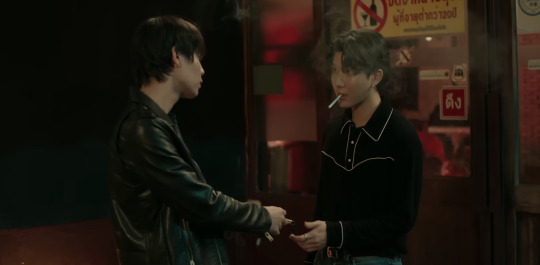
"why don't you just quit smoking, if you're not going to carry a lighter?"
absolutely absurd, sand. the logical framing of this q is why don't you just carry a lighter, if you're going to keep smoking? but of course this question is not really about the lighter, it's about sand. why don't you just quit coming after me, if you're not going to be serious about us?

as we will be shown in the very next scene, ray does, in fact, carry a lighter.
I wOnder what that could mEan??
#my entire reaction to that first scene was surprise at how much narrative setup sandray is getting#not the preview faking us yet again where it's not (just) sand moping over ray but ray moping over sand from jump. bb you can't have it all#ofts#only friends the series#ofts meta#raysand
77 notes
·
View notes
Text

...I... I do not know what on earth compelled me to make this nor why, but I will not be taking criticism at this time
#Moon posting#Break Week is rough y'all#Please I just needed to shitpost a little let me have this#OP Meta#I know this chart is incomprehensible you just have to accept it for what it is#No I was kind of thinking to myself it was kind of funny how of the OG Shichibukai half of them are either dads or borderline dads#And I was like. Can I make a chart of this. Can I make a Dad Chart of the Warlords.#I don't know why I made this nor what to do with this information but. Sure. Let me yeet this out.#Kuma is the Dadliest Dad to Ever Dad in One Piece. Moria canonically adopted Perona when she was little. We love the OG Goth Dad#Crocodad is real TO ME but if nothing else he does have the energy 100%. It's just short of Canon Confirmation at this point#Mihawk is a weird uncle to me. He has no dad energy. This man does not fuck. But he'll look after some kids (Zoro & Perona). Sure.#Blackbeard is like the opposite of Mihawk. He has never looked after a child but I'm sure he has spawned a bastard or two or three#(He may be a father but he is not a Dad) (But canonically as far as we know BB has no kids yet so I'm putting him in Not A Dad)#Jinbei is the new Token Father of the Strawhats according to Oda and so I'm putting him where he is based on that. Also vibes#Law's where he is kind of for similar reasons as Jinbei. This boy is too young to be a dad but dealing with Luffy gave him a few grey hairs#Doflamingo did arguably watch over Buffalo and Baby 5 as those two grew up so he's The Most Qualified in that square#Weevil is baby#Hancock could have Dad Energy in the right circumstances. Like she has THE POTENTIAL#Buggy does not fuck#...Thinking about it I probably should've switched Hancock and Buggy's placements on the chart but whatever it doesn't matter
73 notes
·
View notes